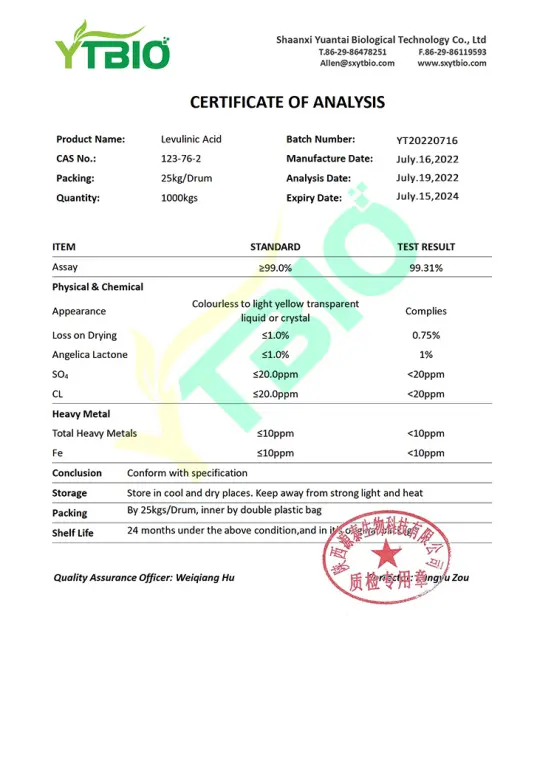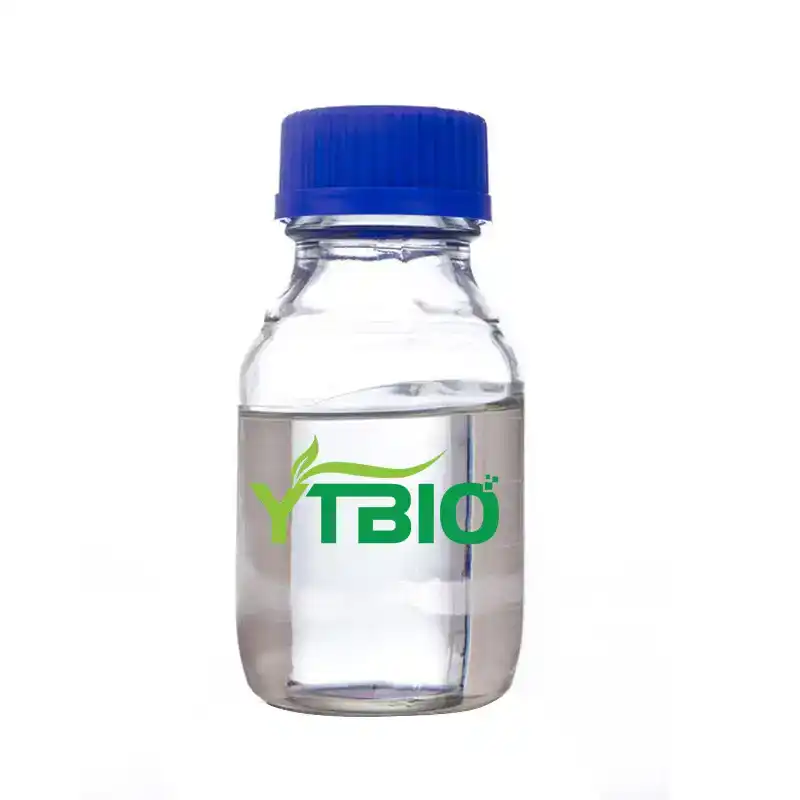Pure Levulinic Acid
CAS: 123-76-2
Specification: 99%
Molecular Formula: C5H8O3
Molecular Weight: 116.12
EINECS No.: 204-649-2
Packaging: 25kg
Storage: Cool, Dry, Away From Light
Payment: T/T,VISA,XTransfer,Alipay......
Shipping Speed: 3-5 days
Certification:cGMP,ISO22000,ISO9001,EU&NOP Organic Certificate,Kosher,BRC,Halal,HACCP
- Fast Delievery
- Quality Assurance
- 24/7 Customer Service
Product Introduction
Do You Know Pure Levulinic Acid?
Pure Levulinic acid , chemically known as 4-oxopentanoic acid, is an organic compound with multiple functional groups. Its structure simultaneously contains carboxyl, carbonyl, and α-hydrogen groups, thus exhibiting rich reactivity in chemical reactions. This compound can participate in reactions as a carboxylic acid or as a ketone, and is suitable for various chemical reaction pathways such as esterification, halogenation, hydrogenation, oxidative dehydrogenation, and condensation. Due to its diverse reactivity, levulinic acid is widely used in the synthesis of various high-value-added products, including but not limited to plastic modifiers, pharmaceutical ingredients, pesticide intermediates, industrial solvents, fragrance raw materials, polymer auxiliaries, lubricant additives, surfactants, ink components, rubber processing aids, and personal care products (such as shampoos and oral care products). In organic synthesis and chemical production, levulinic acid, with its flexible reactivity, has become an important raw material in the fields of medicine, agriculture, and fine chemicals.

YTBIO: Providing High-Quality Pure Levulinic Acid And Services
Why choose YTBIO? We hold the following certifications:
- cGMP, ISO9001, and ISO22000 certifications ensure rigorous quality control throughout the entire process;
- BRC and HACCP system certifications ensure product safety and reliability;
- EU and NOP organic, kosher, and halal certifications meet various global standards and dietary requirements.
We specialize in the research, development, and production of natural plant extracts, cosmetic active ingredients, and health foods. We primarily produce plant extracts, health food ingredients, and a variety of end-use products, including capsules, softgels, granular capsules, gummies, tablets, and solid beverages. Our production facilities and equipment meet national standards, and our production processes strictly adhere to GMP requirements. If you have any questions, please feel free to contact us at sales@sxytorganic.com

Pure Levulinic Acid: Diverse Applications
Pure levulinic acid (C₅H₈O₃), as a key platform compound, demonstrates broad application potential in multiple industrial and technological fields due to its unique molecular structure.
1. As a Key Intermediate in Chemical and Energy Processes
Pure levulinic acid is an important starting point for the synthesis of high-value chemicals. Through processes such as catalytic hydrogenation, it can be efficiently converted into products such as γ-valerolactone (GVL) and 2-methyltetrahydrofuran. The former is considered a widely used green solvent and platform molecule, while the latter can be used as a biofuel additive and high-performance solvent, providing a feasible route for the development of renewable fuels.
2. Important Role in Pharmaceutical and Agricultural Chemistry
This compound and its derivatives are key building blocks in the synthesis of various drugs. For example, its derivative 5-aminolevulinic acid (ALA) is not only used as a photosensitizer precursor in photodynamic therapy but also as an environmentally friendly pesticide. Furthermore, calcium salts derived from levulinic acid also have specific applications in pharmaceutical formulations, demonstrating its cross-disciplinary value in the life sciences.
3. Functional Applications in Materials Chemistry
In the field of materials science, levulinic acid is commonly used to synthesize additives that improve the properties of polymer materials, such as plasticizers, rubber vulcanizing agents, and surfactants. These derivatives can effectively regulate the flexibility, stability, or processing rheology of materials, thereby expanding the application range of traditional materials.
4. Applications in the Daily Chemical and Fragrance Industries
Due to its tunable chemical properties, levulinic acid and its ester derivatives are also used in the formulation of fragrances and flavorings, and as functional additives in cosmetics and personal care products to optimize the sensory characteristics and user experience.
Pure levulinic acid, as a multifunctional molecule bridging traditional chemical engineering and the emerging bioeconomy, continues to drive progress in green synthesis and sustainable development technologies through its diversified applications in energy, pharmaceuticals, and materials.

Expanding Knowledge: Pure Levitinic Acid from Lignocellulosic Biomass – From Waste Plants to Valuable Chemicals
With the increasing consumption of fossil fuels and the growing severity of environmental problems, developing renewable and green energy and chemical resources has become a global consensus. Among numerous options, lignocellulosic biomass—such as crop straw, forestry waste, and bagasse—shows enormous potential due to its wide availability, low cost, and renewability. It is not only an ideal raw material for biofuel production but also a "treasure trove" for synthesizing various high-value chemicals.
Among these high-value chemicals, levulinic acid is particularly noteworthy. Recognized by the U.S. Department of Energy as one of the most promising platform compounds, its molecule contains both carboxyl and carbonyl groups, exhibiting high chemical reactivity and serving as a key precursor for the synthesis of pharmaceuticals, fragrances, polymers, fuel additives, and many other products.
The Path from Biomass to Levitinic Acid
Lignocellulosic biomass is mainly composed of cellulose, hemicellulose, and lignin. Cellulose and hemicellulose can be degraded and ultimately converted into levulinic acid. This process primarily relies on acid catalysis and has two main technical pathways:
Cellulose Pathway (Mainstream Pathway):
This is the most common preparation route. First, cellulose is hydrolyzed into its basic unit—glucose—under acid catalysis. Then, glucose is isomerized to fructose. Next, fructose is further dehydrated to generate a key intermediate—5-hydroxymethylfurfural (HMF). Finally, HMF continues to react under acidic conditions, ultimately producing the target product, levulinic acid.
Hemicellulose Pathway:
This pathway starts with hemicellulose. Hemicellulose is first hydrolyzed into pentoses such as xylose. Xylose is dehydrated under acid catalysis to produce furfural. Furfural is then hydrogenated and reduced to furfuryl alcohol. Finally, furfuryl alcohol is hydrolyzed under Lewis acid catalysis to form levulinic acid.
Challenges: Despite the clear technical routes, the actual production process still faces many challenges, such as the need for harsh reaction conditions like high temperature and high pressure; the need to improve the yield of the target product; and the high cost of catalyst recovery. These are currently the focus of research efforts.
The Broad Application Prospects of Pure Levitinic Acid
Through catalytic conversion, levulinic acid derived from biomass can be used to generate a series of high-value-added products with a wide range of applications:
Green Energy: Levitinic acid can react with alcohols (such as methanol and ethanol) to produce corresponding esters, which can serve as highly efficient biodiesel additives. Furthermore, its derivative, 2-methyltetrahydrofuran, has extremely high compatibility with gasoline, making it a promising gasoline substitute.
Pharmaceuticals and Materials: Levitinic acid is an important raw material for the synthesis of various pharmaceutical intermediates (such as the intermediate for the anti-inflammatory drug indomethacin). Its reaction with calcium carbonate to produce calcium decanoate can be used intravenously in medicine, contributing to bone formation and maintaining neuromuscular function.
Daily Chemicals and Fine Chemicals: Adding levulinic acid and its derivatives to cosmetics can regulate sebum, provide antibacterial and anti-inflammatory effects, and has a good effect on treating acne. It is also a key raw material for the synthesis of fragrances such as jasmine extract.
In conclusion, starting with waste lignocellulosic biomass to produce the high-value platform molecule pure levulinic acid, and then converting it into fuels, pharmaceuticals, and fine chemicals, represents a green chemical pathway for achieving resource recycling and promoting sustainable development, possessing significant economic and social value.

Reference:
YANG J X, SI C L, LIU K, et al. Production of levulinic acid from lignocellulosic biomass and application[J]. Journal of Forestry Engineering, 2020, 5(5):21-27.
FAQ
Q1: Please briefly introduce YTBIO's levulinic acid product.
A1: The levulinic acid provided by YTBIO, chemically known as 4-oxopentanoic acid, is a high-purity platform compound. The product meets stringent international standards such as cGMP, with a purity of up to 99%, and is widely used in pharmaceuticals, food flavorings, green solvents, polymers, and agrochemicals, among many other fields.
Q2: What are the product specifications and packaging?
A2: We guarantee that the purity of the main component of the product is no less than 99%. Standard packaging is 25 kg/drum, ensuring safe transportation and convenient storage. We can also provide customized packaging solutions according to customer needs.
Q3: How does YTBIO guarantee product quality?
A4: YTBIO has a complete quality management system and holds multiple authoritative certifications, including cGMP, ISO9001, ISO22000, BRC, and HACCP. We have also obtained EU & NOP organic certification, as well as Kosher and Halal certifications, enabling us to meet the stringent requirements of different markets and customers worldwide.
Q4: How should this product be stored?
A4: To ensure long-term product stability, it is recommended to store it in a cool, dry, and dark place in a sealed container.
Q5: Can you provide samples?
A5: Of course. We are happy to provide you with free samples so you can evaluate the quality of our products. Samples are free, but you will be responsible for the shipping costs.
Q6: How do I place an order and pay?
A6: After your order is confirmed, we will first send you a pro forma invoice containing our bank details. We accept payment via various convenient methods, including wire transfer, Western Union, PayPal, or third-party guaranteed transactions.
Q7: What is the delivery time? How is logistics handled?
A7: After receiving payment, we typically prepare and ship your product within 5-8 business days. We can arrange ocean freight, air freight, or international express delivery based on your needs. We work with trusted logistics partners to ensure safe and timely delivery of your goods to your designated port or address.
Q8: How do I get started with YTBIO?
A8: We are eager to collaborate with major global brands and partners. Please visit the YTBIO official website and submit your specific requirements through the "Contact Us" page. Our professional team will promptly provide you with detailed product technical documents (TDS), certifications (COA), and competitive solutions.
_1737093401309.png)

